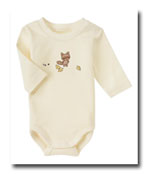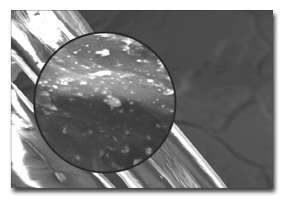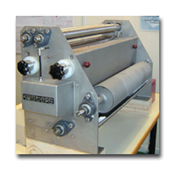T
extile fabrics have a long history of use in agriculture. The term “agrotextiles” now is
used to categorize the woven, nonwoven and knitted fabrics used for agricultural and horticultural
applications including livestock protection, shading, weed and insect control, and extension of the
growing season.
Shade Cloth Uses
One of the first major uses for agricultural shade cloth was as cover for large fields of
tobacco. Lightweight cotton cloth was used to shade plants destined for use as cigar wrappers.
Most plants purchased for indoor household and office uses are of tropical origin, from
Central and South America and from Africa, and grow in jungle-type environments. Nurseries in South
Florida and other Gulf Coast states import these tropical plant seedlings and grow them to the
appropriate size in fields covered by shade cloth. Fabrics are woven to provide different degrees
of shade according to individual plant requirements.
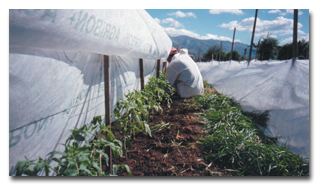 A worker uses Polymer Group Inc.’s Agribon™ nonwoven fabric product in the fields to
A worker uses Polymer Group Inc.’s Agribon™ nonwoven fabric product in the fields to
provide temperature control and light filtration, and to deter pests.
Woven Shade Cloth Fabrics
Polypropylene (PP) is the most-used polymer for woven shade cloth fabrics. The resin is
formulated with additives and pigments to provide resistance to sunlight and weathering. Black
pigmentation helps provide a high degree of sunlight resistance. Much of the shade cloth is made
from monofilament yarn, although some film fiber yarns also are used. Wide-width fabrics minimize
the amount of seaming needed for installation.
Calendering is an important finishing operation that aids in giving a fabric the desired
shade percentage. Where greater stability is needed in a woven shade cloth, leno weave
constructions such as NicoShade® can be used. NicoShade is a leno/lock woven PP shade material for
the agricultural marketplace manufactured by Ten Cate Industrial Fabrics – an operating unit of the
Netherlands-based Royal Ten Cate.
Other Woven
Polyolefin Agrotextile Applications
Woven fabrics made with PP monofilament also are used as side curtains for wooden poultry
houses. The curtains provide ventilation, yet protect birds from foul weather. Some fabrics
are extrusion-coated and then run through spiked rollers to improve their porosity.
Extrusion-coated PP fabrics are used for hog houses in some areas of the country. Farmers use white
woven PP fabric for barn wall siding as a way to add ventilation and reduce building costs.
Insect screening for greenhouses is another important application for woven agrotextiles.
These fabrics are made from fine-denier polyethylene (PE) or PP monofilament, typically with a size
of 0.018 inch. More closely woven fabrics, with a hole size as small as 0.0075 inch, are required
in areas of the country where pests such as Western flower thrips prevail.
Netting Products
Extruded netting products, which usually are classed as nonwovens, have found extensive uses
in agrotextile applications. Extruded nettings are polymeric mesh-like or scrim-like structures
produced by extrusion. Smith & Nephew Extruded Films, a division of Smith & Nephew,
England, developed much of the initial technology for these products.
The company patented a method of producing net-like fabrics from polymeric materials by
importing grooves in both sides of a continuous sheet of film with grooves that extend through the
sheet, so that the added depth of the grooves in each surface is only slightly less than the full
thickness of the sheet. The grooves on one surface of the film are arranged to cross the grooves on
the other. The crossing points have only the reduced thickness of the material separating the base
of the grooves. The sheet of film is then subjected to biaxial stretching, such as on a tenter
frame, to give the thinned parts of the sheet at the crossing points of the grooves a permanent
set, so that they split and form perforations at the point.
Conwed, Minneapolis, is one of the largest US merchant producers of extruded nettings. Its
original oriented extruded nettings were made through a proprietary process of uniaxial or biaxial
orientation. After extrusion, the netting is stretched under controlled conditions to maximize the
strength-to-weight ratio per strand. The orientation process also regulates netting thickness,
flexibility, width and strand count. Realignment of the resin’s structure during orientation
produces a monofilament, square mesh construction with a high strength-to-weight ratio. Each joint
becomes an integral part of the netting, allowing for equal distribution of the stress.
In 2004, Conwed introduced BioGrid, the first truly biodegradable oriented netting. Early
this year, the company unveiled its OxyGrid™ degradable netting, made with polymers that oxidize
and degrade from exposure to heat and moisture. This product is effective in erosion control
applications where it immediately begins to break down. Exposure to sunlight accelerates the
breakdown process.
Conwed sells Sodnet® turf reinforcement for accelerated turf grass production. According to
the company, Sodnet enables grass to grow as the roots entwine with durable mesh, resulting in the
early harvesting of thinner turf in strong slab or roll form. The extruded nettings are of the
biaxial type of PP and are pigmented green or black.
The advantages of Sodnet for reinforcing turfgrass include:
• an earlier harvest – in many cases cutting in half the time to harvest;
• improved handleability – sod can be cut more thinly and is
lighter-weight;
• reduced irrigation and other maintenance costs due to shorter growing
cycles;
• minimized waste – reduces scrap from broken rolls;
• ability to grow varieties that lack well-developed root systems such as
tall fescue and ryegrass; and
• maximized effective use of land – frees up land for alternative crops.
Conwed also supplies a range of extruded netting fabrics that protect fruit crops from bird
damage. Birdnet is used to protect grapes, blueberries, strawberries and cherries. Tests cited by
Conwed demonstrate Birdnet can be mechanically applied or removed at a rate of 1.5 to two acres per
hour. The average installation cost would be $25 to $35 per hour, plus an average initial netting
cost of 8 to 13 cents per linear foot.
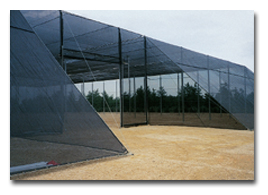 Ten Cate Industrial Fabrics’ NicoShade® is a leno/lock woven polypropylene shade material
Ten Cate Industrial Fabrics’ NicoShade® is a leno/lock woven polypropylene shade material
for the agricultural marketplace.
Capillary Mats For Greenhouses
Placement of needlepunched PP fabrics under growing plants in greenhouses was one of the
earliest uses of nonwovens as agrotextiles. The nonwoven fabric saturates easily by capillary
action, and helps to keep the plants moist and to raise the humidity level in the greenhouse.
The advantages of PP capillary mats over the rayon products they replaced include: lighter
weight; higher wet strength; resistance to rot, mildew and chemicals; ease of cutting and shaping
to table size; quick absorption of water and quick wicking action; crush resistance; and
reversibility.
Tyvek® Irrigation System
International Irrigation Systems, Niagara Falls, N.Y., sells its Irrigro® system for
home gardeners and garden centers. The system uses the micropores in Wilmington, Del.-based
DuPont’s spunbond high-density PE Tyvek® in tubular form to efficiently irrigate planting areas.
The tubing can be layered beside plant stems or buried under several inches of soil for uniform
continuous watering of the root zone. The system also may be used to deliver plant nutrients and
insecticides. The millions of fine fibers in the fabric allow droplets of the irrigation water to
escape the tubing uniformly. A threshold of pressure is required before any significant emission of
water starts. As soon as the entire system is filled with water and the pressure exceeds 1 pound
per square inch, simultaneous emission of water starts throughout the entire system. This prevents
the first few feet of the area from being overwatered. The system can be operated continuously for
a month with the same volume of water that a sprinkler uses in an hour.
Nonwovens As Crop Covers Or Row Covers
Nonwovens are replacing some of the straw, glass and plastic films that have been used for
many years to protect crops from freezing. They now are used to accelerate plant growth early in
the season.
Lightweight cotton fabrics were used for many years to prevent newly planted seeds from
being washed away. Stabilized spunbond PP fabrics that weigh in the range of 0.3 to 1 ounce per
square yard are replacing cotton fabrics for this use and also may be used as a crop cover.
Most vegetables respond well to the use of floating row covers of nonwoven materials.
Generally, covers are used from a week before the frost-free date until flowers appear four to six
weeks later. Covers are stored and sometimes put back in the fall to protect the fruit or
vegetables from an early frost. Early yields bring more dollars per pound for the farmer, and
higher yields result in more total dollars.
Strawberries are a crop for which early and total yields have been enhanced by floating row
covers. They can be protected with row covers down to 22°F to 24°F, depending on wind speed and
freeze duration. Tree seedlings and nursery stock also benefit from use of row covers, which
prevent the heaving of seedlings by hoarfrost as well.
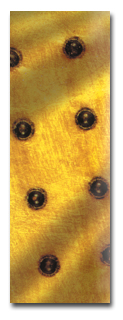 Biobarrier® fabric from Reemay Inc., a member of BBA Fiberweb™, features an in-soil
Biobarrier® fabric from Reemay Inc., a member of BBA Fiberweb™, features an in-soil
herbicidal barrier that can block roots without harming plants.
PGI’s Spunbond
Fabric For Harvesting Better Bananas
Polymer Group Inc. (PGI), North Charleston, S.C., has added Agribon® barrier spunbond to its
line of nonwoven products for agricultural use. Among other uses, the fabric protects banana
bunches on the tree against physical external damage, diseases and pests without the use of
insecticides. PGI has participated in extensive studies in Central and South American
banana-growing areas using the Agribon barrier products. The bananas covered by Agribon had
enhanced fruit coloration and better distribution of the fruits in the bunch from the top to
bottom, in addition to being protected from insects. Agribon may be reused with appropriate
handling of the bag. PGI’s spunbond plant in Colombia will be the source for spunbond fabrics used
for these applications.
Nonwovens As Landscaping Fabrics
PP spunbond nonwovens are the dominant products used for landscaping fabrics because of
their durability and relatively low cost. Some of the major landscaping uses for the fabrics are as
follows:
• soil retention and weed control for landscaped areas and gardens;
• soil retention for retaining walls made of timber;
• weed control under decks;
• brick walkway and patio support;
• planter and pot drainage;
• linings for interceptor trench drains; and
• protection for newly seeded areas.
One successful specialty agrotextile is Biobarrier® fabric for root control, manufactured by
Hickory, Tenn.-based Reemay Inc. – a member of BBA Fiberweb™. This product combines a spunbond PP
fabric with a time-released herbicide, creating an in-soil herbicidal barrier that can block roots
without harming plants. The system is guaranteed for 15 years. The pellets that are adhered to the
spunbond are impregnated with the herbicide trifluralin. The herbicide is mixed with carbon black
and PE and molded into pellets. The specific formulation selected controls the rate of release of
the herbicide.
Metallized woven and nonwoven agrotextile products are finding applications in greenhouses,
plant nurseries and orchards. These fabrics may be used in greenhouses to prevent heat loss.
Installations of these fabrics also can be designed to protect plants from excessive solar
radiation.
Diversified Fabrics Inc., Kings Mountain, N.C., uses its Reflec-Tex® process for metallizing
nonwoven and woven fabrics for agrotextiles and other applications. F.J. Broadwell, president,
reports the company is metallizing these fabrics for use in greenhouses and orchards. A specific
application he cites involves using the metallized woven fabrics under apple and peach orchards.
The reflected sunlight from the fabric hastens fruit ripening and provides fruit with more uniform
color. The first pickings are larger, and often a fewer number of pickings are required. The
fabrics also minimize weed growth in the orchard.
September 2005
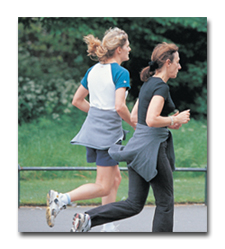


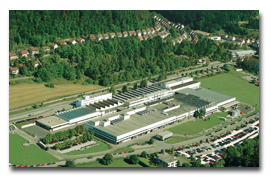
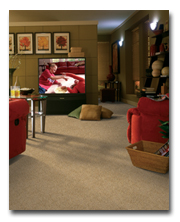



 Cotton Incorporated, Cary, N.C., has teamed up with children’s apparel retailer Gymboree
Cotton Incorporated, Cary, N.C., has teamed up with children’s apparel retailer Gymboree